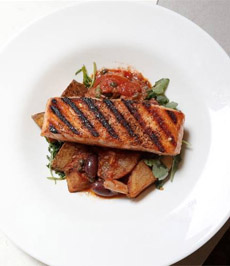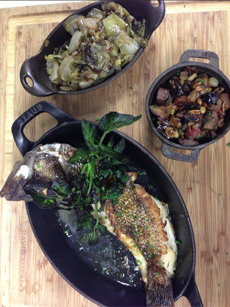TIP OF THE DAY: Ways To Use Eggplant Caponata
|
Caponata is a Sicilian eggplant relish or eggplant salad, made from capers, eggplant, onion, pine nuts and tomatoes, usually served as a side dish or relish, part of an antipasto. In Sicily it’s called capunata.
As with any recipe, there are numerous variations, including the addition of carrots, celery, green bell peppers, olives, potatoes, or raisins. According to food writer Clifford A. Wright, the famed Italian dish may be of Spanish origin. He quotes the Sicilian food authority Pino Correnti, that the dish is derived from the Catalan word caponada, a similar type of relish Th Catalan word means “something tied together like vines.” In Sicily, it first appears in 1709. Another contender is the word capón; capón de galera is a gazpacho or a caponata-like dish. A Sicilian cuisine scholar, Giuseppe Coria, suggests that the word derives from the Latin caupo, tavern, which served cauponae, a tavern food for travelers. Wright notes: “The earliest recipe I am familiar with of … a kind of caponata is the cappone di galera alla siciliana in Francesco Leonardi’s L’Apicio Moderno (The Modern Apicius), published in 1790. Here is his recipe: |

Caponata moves from appetizer dip or spread to a sauce for fish or poultry. You can place the caponata on top of the protein or use it as a bed, as shown in this photo. Photo courtesy Olio e Piú | New York City. |
|
|
“Dip a few fresh new beans [freselle maiorchine, an esteemed bean from Majorca] in Malaga wine, then arrange them on a serving platter, and put over them a garnish of anchovy fillets and thin slices of tuna salami, rinsed of its salt, capers, pieces of citron zest, stoned olives, fried shrimp and squid, oysters poached slightly in their own liquid and several fillets of fried linguattola [Citharus linguatula, a kind of flatfish] until the platter is well garnished and full. At the moment of serving pour over it a sauce made as follows: in a mortar pound two ounces of peeled green pistachios soaked in olive oil, vinegar, and tarragon or vinegar, salt, and ground pepper.” Whatever the origin and ingredients, today’s caponata easily moves from antipasto relish (our grandmother favored it with crackers or toasted baguette slices) to the main plate. This delicious and healthful garnish adds bright color to pale proteins. It works well on grilled, poached or sautéed fish, poultry or tofu. Use fresh tomatoes in season. In the off season, use diced, canned tomatoes. Caponata tastes best the day after it is made, once the flavors have had a chance to blend and mellow. The recipe can be made two days in advance and refrigerated, covered. It can also be frozen. You can serve caponata warm, chilled or at room temperature, or cold. |
||
 Grilled bass with eggplant caponata. Photo courtesy David Burke Fromagerie. |
Ingredients 1. HEAT the oil in heavy pot over medium heat. Add the eggplant, onion and garlic. Sauté until the eggplant is soft and brown, about 15 minutes. |
|
|
Preparation 1. HEAT the oil in heavy pot over medium heat. Add the eggplant, onion and garlic. Sauté until the eggplant is soft and brown, about 15 minutes. 2. ADD the diced tomatoes, vinegar and drained capers. Cover and simmer until the eggplant and onion are very tender, about 12 minutes, stirring occasionally. 3. SEASON the caponata to taste with salt and pepper. Mix in the basil. Transfer to a serving bowl. Sprinkle with toasted pine nuts. This recipe was adapted from Epicurious.com.
|
||


